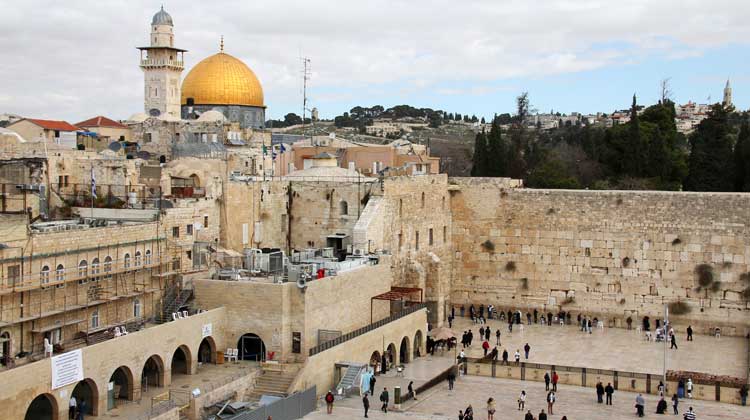
When President Donald Trump followed through with his campaign promise to move the U.S. embassy to Jerusalem, he effectively recognized Israel’s sovereign rights to the city. Predictably, the age-old conflict between Israelis and Palestinians escalated. Although there has been little respite from the fighting between these two peoples since shortly after World War II, there have been peaks and valleys.
Those distant from the situation, and with little foundational knowledge of associated issues naturally wonder where the whole thing is going. The most often voiced interrogatory is: “Is it possible for a lasting peace in the region? And if the answer is yes, what factors will emerge to make this happen?”
Populated by close-knit families and groups of people prone to promulgating and socially supporting actions foundationally rooted in age-old grievances, the region has seldom seen long periods of Israeli-Palestinian cooperation. Still, the people who call the area home share a goal of living and raising their families in an atmosphere of calm, absent the horrendous violence.
Assuming this is true, observers would naturally expect both sides to take steps—however small—to move the region toward peace and stability. Why, then, do we see no such thing on the horizon? Why does it seem that terror and violence will rule the region forever? The answer may lie more in psychology than in politics.
A foundational need—as essential as food and water—is the need for an identity. Human beings are driven to understand who and what they are. Implicit in this knowledge is a grounded perception of one’s character, values, allegiances, and foundations that support growth. This need is most often satisfied by membership in a group of some sort, but it implies much more.
Being part of something can be exemplified metaphorically as the ends of dozens of pieces of yarn connected by a single drop of glue. As the glue solidifies and pieces of yarn become permanently rooted, the remaining lengths of each piece may diverge in many directions while the ends are held tight in the drop of glue. Safeguarded within that drop are the characteristics, values, identities, and sacred qualities that define the group, while the strings represent individuals within the group. No matter what happens, no matter how many directions the winds of life take them, they are always secure in who and what they are.
An example of this can be found in Vietnam veterans. The Vietnam experience was so exaggerated for the men and women who served, those who survived and returned home forevermore identified themselves almost exclusively as “Vietnam vets.” If it were possible to take that away from them, most would find themselves stripped of everything that defined them. They would basically be nothing.
Palestinians identify themselves with their group, and the group identifies itself with the struggle, or what it means to be a Palestinian. They are, of course, members of different clans and tribes, and this is important, but of much more importance to them—especially the younger generations—is the cause signified by struggle.
This struggle is exemplified and defined by violence. It is a type of violence that is sanctified at the highest level and is, in fact, to many, deity directed, which makes the constant willingness to fight a consecrated characteristic that defines them. They are the oppressed. They are the beleaguered. They are the “David” to the world’s “Goliath,” and as such they are righteous. Their righteousness, in this sense, becomes an all-important ingredient, or characteristic, in the glue that holds them together and forms the basis of who they are.
It is important to note that Palestinians are not inherently wired, nor unquestionably predestined to follow the path of violent resistance. They begin this life the same way you or I. Just as you or I, however, they are highly subject to the life prompts and encouragements to which all young people are subject. In fact, many Palestinians and Palestinian groups have struggled for lasting peace in the region. The pathway toward violent resistance, however, is demanding. Once on it, it is virtually impossible to veer away.
Each time Israel or Israel’s allies such as the United States take a step like the embassy move, or the mass media supports Israeli claims of Palestinian terrorism, the glue and the embodied characteristics are strengthened and reinforced. Nothing reinforces foundational aspects of who a person—or in this case, a group—like violence. Violence experienced or violence committed in response to perceived actions is a mighty measure of who we are as humans. Americans for example, were never “more American” than they were immediately following Pearl Harbor, or 9/11.
Being a member of a group like the Palestinians provides not only validation and encouragement, but probably a strong sense of collegiality and comradeship. For a young person, life is exciting and has meaning when you are consistently oppressed and plagued, especially by a stronger enemy. A life and death struggle provides zest and passion.
Contrast this with a life in a homeland you not only own, but a homeland that is free from the type of challenge we see in present day Israel.
At this point in history, Palestinians—especially the younger generation—aren’t simply Palestinians; they are part of all the ingredients that were infused into the drop of glue. If this is taken away from them through a peace that is sound and can last—even a peace that gives them the homeland they have envisioned—they will be a people without an identity. Some would settle for this—the older generation, weary of fighting and conflict—but most couldn’t survive it.
The simple fact is, peace in Israel will require much more than a homeland.
Godfrey Garner is a regular contributor to Homeland411.